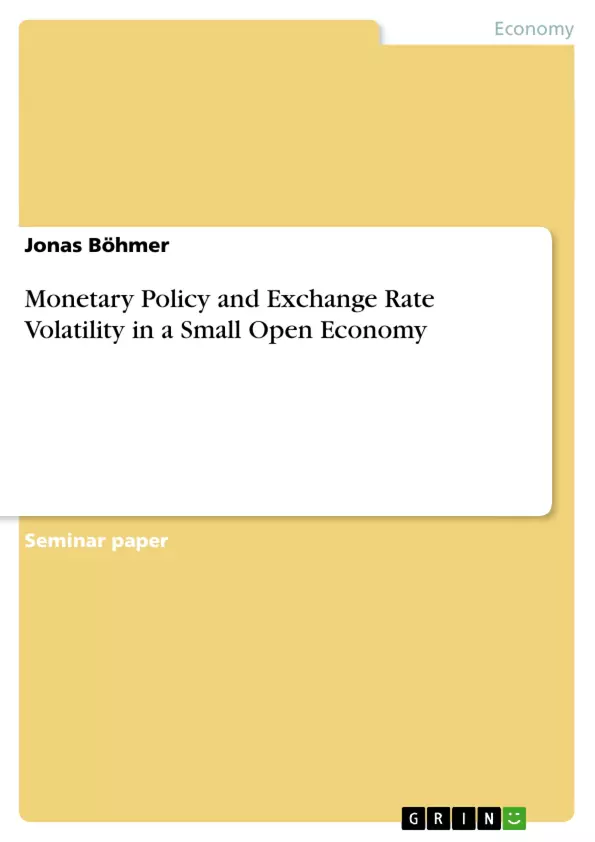Does inflation reduce welfare? What is worse, a volatile exchange rate or a high inflation rate? And is the central bank able to drive these variables?
These questions are the topic of a paper by Jordi Gali and Tommaso Monacelli, published in 2005 and titled “Monetary Policy and Exchange Rate Volatility in a Small Open Economy”. As apparent by the title Gali and Monacelli (G+M) analyze the influence of monetary policy on the volatility of the exchange rate, more precisely the nominal exchange rate and the terms of
trade. For this purpose they create a small open economy with sticky prices of Calvo-type. Due to its minor size this economy does not influence the world economy. However, depending on
the degree of openness this economy is affected by the rest of the world.
Having specified this framework, G+M introduce three different monetary regimes and evaluate the resulting exchange rate volatilities . Using a central bank loss function G+M rank these three rules according to the implied welfare which shows a positive correlation between welfare and exchange rate volatility. Thence G+M prefer Taylor rules over an exchange rate pegging.
To get a general idea of Gali and Monacelli`s argumentation this expose will start in chapter 2 with an abbreviated overlook over G+M’s model of a small open economy. In the following chapter there will be the introduction of the three central bank rules, necessary to close the model, as well as an analysis of the underlying welfare levels. Since the welfare evaluation is
based on some special assumptions, chapter 4 will give an overview of recent literature which discusses possible extensions as well as their implications for G+M’s ranking of implied welfare. Concluding chapter 5 will summarize G+M’s most important results as well as evaluate if the possible extensions render G+M’s analysis, respectively their results, worthless.
Inhaltsverzeichnis (Table of Contents)
- Introduction
- Gali and Monacelli's small open economy
- The supply side
- The demand side
- Several aggregating indices
- Household optimization
- Exchange rates and terms of trade
- Risk sharing and uncovered interest rate parity
- The equilibrium
- Monetary policy and welfare
- A benchmark regime
- Taylor rules and pegging
- A welfare evaluation
- Extensions of G+M's economy
- Conclusion
Zielsetzung und Themenschwerpunkte (Objectives and Key Themes)
This paper by Jordi Gali and Tommaso Monacelli investigates the relationship between monetary policy and exchange rate volatility in a small open economy. The authors develop a model with sticky prices and analyze the welfare implications of different monetary policy regimes. The main themes explored in the paper include: * The impact of monetary policy on exchange rate volatility in a small open economy * The welfare implications of different monetary policy regimes, including Taylor rules and exchange rate pegging * The role of price stickiness and openness in determining exchange rate behavior * The relationship between exchange rate volatility, inflation, and welfare * The potential limitations and extensions of the modelZusammenfassung der Kapitel (Chapter Summaries)
This section provides summaries of each chapter in the text, excluding the conclusion. **Chapter 2: Gali and Monacelli's Small Open Economy** This chapter presents an abbreviated overview of the model developed by Gali and Monacelli to represent a small open economy. The model includes sticky prices, a representative household, and a demand side driven by consumption and leisure. It outlines the supply side, the demand side, and the equilibrium of the economy, focusing on the key equations and results. **Chapter 3: Monetary Policy and Welfare** Chapter 3 introduces different monetary policy regimes, including a benchmark regime, Taylor rules, and exchange rate pegging. It analyzes the resulting exchange rate volatilities and evaluates the associated welfare levels using a central bank loss function. The analysis aims to determine which regime leads to higher welfare and how exchange rate volatility relates to welfare. **Chapter 4: Extensions of G+M's Economy** Chapter 4 examines extensions to the model presented in the earlier chapters, considering possible limitations and their implications for the ranking of implied welfare. This chapter focuses on recent literature that discusses potential modifications and their effects on the analysis and results.Schlüsselwörter (Keywords)
The paper focuses on the interaction between monetary policy, exchange rate volatility, and welfare in a small open economy. Key concepts and themes include: monetary policy, exchange rate volatility, welfare, sticky prices, Taylor rules, exchange rate pegging, small open economy, price stickiness, openness, inflation, and the Gali-Monacelli model.- Citar trabajo
- Diplom Volkswirt Jonas Böhmer (Autor), 2008, Monetary Policy and Exchange Rate Volatility in a Small Open Economy, Múnich, GRIN Verlag, https://www.grin.com/document/135689



